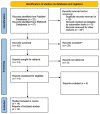CT Perfusion in Lacunar Stroke: A Systematic Review
- PMID: 37174955
- PMCID: PMC10177869
- DOI: 10.3390/diagnostics13091564
CT Perfusion in Lacunar Stroke: A Systematic Review
Abstract
Background: The main theory underlying the use of perfusion imaging in acute ischemic stroke is the presence of a hypoperfused volume of the brain downstream of an occluded artery. Indeed, the main purpose of perfusion imaging is to select patients for endovascular treatment. Computed Tomography Perfusion (CTP) is the more used technique because of its wide availability but lacunar infarcts are theoretically outside the purpose of CTP, and limited data are available about CTP performance in acute stroke patients with lacunar stroke.
Methods: We performed a systematic review searching in PubMed and EMBASE for CTP and lacunar stroke with a final selection of 14 papers, which were examined for data extraction and, in particular, CTP technical issues and sensitivity, specificity, PPV, and NPV values.
Results: A global cohort of 583 patients with lacunar stroke was identified, with a mean age ranging from 59.8 to 72 years and a female percentage ranging from 32 to 53.1%.CTP was performed with different technologies (16 to 320 rows), different post-processing software, and different maps. Sensitivity ranges from 0 to 62.5%, and specificity from 20 to 100%.
Conclusions: CTP does not allow to reasonable exclude lacunar infarct if no perfusion deficit is found, but the pathophysiology of lacunar infarct is more complex than previously thought.
Keywords: CTP; MRI; RSSI; SVD; lacuna; lacunar stroke; perfusion; recent small subcortical infarct; small vessel disease; stroke.
Conflict of interest statement
The authors declare no conflict of interest.
Figures

References
-
- Campbell B.C.V., Ma H., A Ringleb P., Parsons M.W., Churilov L., Bendszus M., Levi C.R., Hsu C., Kleinig T.J., Fatar M., et al. Extending thrombolysis to 4·5–9 h and wake-up stroke using perfusion imaging: A systematic review and meta-analysis of individual patient data. Lancet. 2019;394:139–147. doi: 10.1016/S0140-6736(19)31053-0. - DOI - PubMed
-
- Berge E., Whiteley W., Audebert H., De Marchis G.M., Fonseca A.C., Padiglioni C., de la Ossa N.P., Strbian D., Tsivgoulis G., Turc G. European Stroke Organisation (ESO) guidelines on intravenous thrombolysis for acute ischaemic stroke. Eur. Stroke J. 2021;6:I–LXII. doi: 10.1177/2396987321989865. - DOI - PMC - PubMed
-
- Thomalla G., Boutitie F., Ma H., Koga M., Ringleb P., Schwamm L.H., Wu O., Bendszus M., Bladin C.F., Campbell B.C.V., et al. Intravenous alteplase for stroke with unknown time of onset guided by advanced imaging: Systematic review and meta-analysis of individual patient data. Lancet. 2020;396:1574–1584. doi: 10.1016/S0140-6736(20)32163-2. - DOI - PMC - PubMed
Publication types
LinkOut - more resources
Full Text Sources

